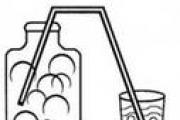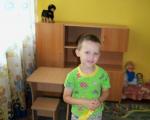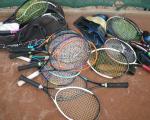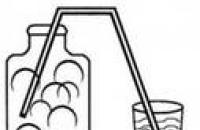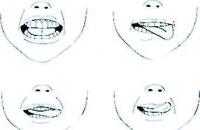Size 1.5 x 15 m
You will need: yarn “Alpaca” (50% alpaca, 50% wool. 50 g/185 m): 400 g each of brown and ecru, 100 g of blue; yarn for finishing (50% wool, 50% acrylic, 50 g / 200 m): 50 g of zryu color.
Weave
Cooking surface.
Knitting density: 30 p. x 41 r. = 10 x 10 cm. Knitted in stockinette stitch on a Silver Reed knitting machine at density 6.
Attention! The blanket is made of three parts, connected to each other during knitting on a Silver Reed knitting machine at density 6.
Description of knitting
For the 1st part, use 150 needles (in zone 75-0-75). Cast on stitches using brown yarn in a pigtail (or cast on with waste thread). Knit in stockinette stitch. Having knitted 6 rows from the beginning of work, *on the right side of the fabric, use a decker to transfer the loop from the 4th needle to the 5th. Leave the freed needle in use. Knit 5 more rows in stockinette stitch*. From * to * repeat until the end of the details. On the 205th row, change the brown yarn to ecru yarn and knit another 204 rows. After 408 rows, change the yarn to brown and knit another 204 rows. After knitting 612 rows on the counter, remove the loops from the needles onto a waste thread.
For the 2nd part, use 150 needles (in zone 75-0-75). Cast on stitches using ecru yarn in a pigtail (or cast on with waste thread). Knit in stockinette stitch. After 6 rows (carriage on the right), start making holes on the right side of the fabric, as on the 1st part. At the same time, on the left side, begin to attach the 1st part as follows: take the part with the wrong side facing you, the holes are located on the right. Insert the three-needle decker into the first hole from the bottom, remove the 3 leftmost loops of the 2nd piece from the needles, pull them through the first hole of the 1st piece and put them back on the needles. Transfer the loop from the 1st needle to the 5th. Knit another 5 rows in stockinette stitch, then again make a hole on the right side and a connection on the left side. After 204 rows, change the yarn to blue. After another 204 rows, change the yarn to ecru yarn. Continue making holes on the left side and connecting parts on the right until row 612. Slip the stitches off the needles onto a waste thread.
For the 3rd part, use 150 needles (in zone 75-0-75). Cast on stitches using brown yarn in a pigtail (or cast on with waste thread). Knit in stockinette stitch, alternating the color of the yarn, as in the 1st part. Connect to the 2nd part on the left side, as described above. After knitting 612 rows on the counter, remove the loops from the needles onto a waste thread.
Assembly:
Steam the blanket. Crochet open loops and remove waste thread. To finish the edge of the blanket with finishing yarn, cast on 4 stitches with a braid. The carriage is on the right. On the same needles, place 4 internodal bows of the edge of the blanket. Knit 8 rows. *Place the next 4 interstitial edge arches on the same needles, knit another 8 rows*. Repeat from * to * along the entire perimeter of the blanket.
What associations do you have with the phrase “winter evening”?.. Surely there will be a table lamp, a cozy chair, a cup of hot tea and a warm, affectionate blanket. Yes, yes, in the original the blanket was plush, but these are not very popular now. But knitted ones consistently remain in trend - after all, on winter evenings it’s so nice to knit them and so cozy to cover yourself with them.
And this useful item came to us from northern Scotland - a windy mountain region. During the day, the mountaineers - both men and women - wore it as outerwear, and at night they used it as a blanket. Scottish plaids were woven, painted in bright colors.
But we owe knitted blankets... to children. Woolen blankets in those years were quite rough, and in order not to damage the delicate skin of babies, blankets were knitted from the softest and most delicate yarn. These blankets were warm and light. it was possible to wrap a baby in them and cover him.
It is not surprising that the boom in hangmade products in the mid-20th century revived the popularity of blankets, especially knitted ones. It was in those years that many very popular models appeared - both knitted and crocheted, and later - made using the machine knitting technique.
Favorites are, of course, blankets made from “Afghan squares”, crocheted. Very simple to make, but at the same time very effective - they are accessible to both complete beginners and professionals. But the main thing is that they are very easy to make: first you knit squares, which are then assembled into a fabric. All that remains is to tie the blanket around the perimeter - and the wonderful thing is ready!
And how many famous techniques they embody: patchwork technique, Irish lace, and knitting!
By the way, knitters also use the same technique: first knit required quantity motives (they can be of different colors and with different patterns), and then they are collected into a single canvas. Experienced craftswomen claim that this is an excellent way to “recycle” knitting samples or yarn remnants. Moreover, when such different motifs, colors and textures are collected in one product, the blankets turn out to be very interesting.
But even if you know how to knit only the most simple patterns- no problem. If you use yarn of different colors, you get truly fantastic things. Although, on the contrary, many people prefer plain blankets - they look very stylish and respectable.
But in any case, a blanket is a very homely, cozy thing, carrying the warmth of a master and warming in the most severe cold. And about any of them you can say:
So cozy and warm.
Snow is flying outside the window.
And my soul is completely light.
Coffee. Book. Warm blanket. ©
Size: 150x150cm.
You will need: 900 grams of Alpaca yarn (100% alpaca, 190m/50g. Trinity Worsted Factory); 400 grams of brown and gray, 100 grams of blue), 50 grams of wool yarn (200m/50g) for finishing.
Weaves: cooking surface.
Knitting density:
30p.x41p.=10x10 cm, knitted in stockinette stitch on a Silver Reed knitting machine at density 6.
Description of work:
The blanket is knitted from three parts, connected to each other during the knitting process.
Detail 1.
Switch on 150 needles (in zone 75-0-75). Use a brown thread to cast on stitches in a pigtail (or cast on using a waste thread). Knit in stockinette stitch. After 6 rows on the right side of the fabric, use a decker to transfer the loop from the quadruple needle to the fifth. Leave the freed needle in use. Knit 6 more rows in stockinette stitch. Again on the right side of the fabric, use the decker to transfer the loop from the quadruple needle to the fifth. And so on. Continue this way until row 204. In row 205, change the thread to a harsh one. Knit another 204 rows in stockinette stitch, making holes on the right side every 6 rows. After 408 rows, change the thread to brown. Knit another 204 rows, making holes on the right side every 6 rows. After 612 rows, remove the fabric onto a waste thread.
Detail 2.
Switch on 150 needles (in zone 75-0-75). Cast on the loops with a pigtail using a straight thread (or cast on using a waste thread). Knit in stockinette stitch. After 6 rows (carriage on the right), start making holes on the right side of the fabric, as in Part 1. At the same time, on the left side, start attaching Part 1 as follows: take the part with the wrong side facing you, the holes are located on the right. Insert the three-needle decker into the first hole from the bottom, remove the three leftmost loops of Part 2 from the needles, pull them through the first hole of Part 1 and put them back on the needles. Transfer the loop from the fourth needle to the fifth. Knit 6 more rows in stockinette stitch, then again make a hole on the right side and join the parts on the left. After 204 rows, change the gray thread to blue. After another 204 rows, change the blue thread again to a harsh one. Continue making holes on the left side and connecting parts on the right until row 612. Remove the part using waste thread.
Detail 3.
Switch on 150 needles (in zone 75-0-75). Use a brown thread to cast on stitches in a pigtail (or cast on using a waste thread). Knit in stockinette stitch. Make the connection from the left side of the first two parts. The carriage should be on the right. Work up to 612 rows with color changes every 204 rows (brown, gray, brown)
Perform an OBE. Crochet open loops and remove waste thread.
Edge processing.
Using wool thread for finishing, cast on 4 loops in a pigtail. The carriage is on the right. Using the same needles, place the four internodal bows of the edge of the blanket. Knit eight rows. Place the next four interstitial edge arches on the same needles and knit another eight rows. Finish around the perimeter of the rug in this manner.
There is always so little time for needlework. Pictures of everything that you want so much fly through your head. Sometimes I have such thoughts that my whole life is not enough to make all the beautiful things that I found on the Internet. That's enough, because knitting can be faster with special knitting machines.
It is enough to purchase a good model with numerous functions and the punch card will do everything you dreamed of. A couple of amazing blanket patterns knitted by machine.
 For a knitting machine, it is better to use special types of yarn for a knitting machine. Beginners and even experienced craftsmen are not always able to guess the correct thickness of the thread.
For a knitting machine, it is better to use special types of yarn for a knitting machine. Beginners and even experienced craftsmen are not always able to guess the correct thickness of the thread.
Plus, the additional settings that the equipment will require are not exactly marked on such threads. But it’s better not to disturb the master so often.
If you want relaxing knitting, choose suitable threads.
Sample
The blanket also requires a pattern. Even a children's blanket cannot do without such a detail.. All products must have a clear size. Or you will have to unravel the whole product, which the knitting machine worked so diligently.
Blanket for a child on a knitting machine
The bright and lively model of this blanket can be made almost by a robot. The product turns out very smooth, even stitches, even patterns. Line to line, it's all more than flawless.
 To work you will need:
To work you will need:
- yarn for a knitting machine, dora threads of several colors (white 3 skeins, yellow 2 skeins and mint 1);
- single-fortune knitting machine.
The threads contain acrylic. They do not contain wool, which can easily cause allergies in a child. The blanket consists of three stripes, which are then simply sewn together.
Page one
At density 10, you need to cast on 72 loops using the entwining method. Change colors according to the following scheme:
- b from 0 to 40;
- f from 41 to 60;
- b from 61 to 66;
- m from 67 to 80;
- b from 81 to 100;
- f from 101 to 110;
- b from 111 to 130;
- m from 131 to 150;
- b from 151 to 200;
- f from 201 to 240;
- b from 241 to 298.
Where the designation m is the mint color of the threads, g is yellow, respectively, and b is its white color for the yarn.
Close the loops with a braid.
Second and third stripes
Knit the second and third brightest stripes in the same way as the first, but according to a modified pattern:
- b from 0 to 20;
- m from 21 to 36;
- b from 37 to 80;
- f from 81 to 100;
- b from 101 to 122;
- m from 123 to 130;
- b from 131 to 150;
- f from 151 to 190;
- b from 191 to 200;
- m from 201 to 216;
- b from 217 to 240;
- f from 241 to 270;
- b from 271 to 298.
Where the designation m is the mint color of the threads, g is yellow, respectively, and b is its white color for the yarn.
The loops for this last row (namely 299), like the first strip, need to be closed with a pigtail.
Important! Before sewing the strips together, it is better to steam them. This way they will not curl and you will get a more even stitching.
Harness
 The edge of the fabric needs to be put on the needles. Put on 10 loops and skip one (send the needle to the non-working position). So all over the side. Knit a total of 4 rows on density 9. You will get a false elastic band 10 to 1. You can decorate with threads (fringe in the places where the 11th loop was missed in each place).
The edge of the fabric needs to be put on the needles. Put on 10 loops and skip one (send the needle to the non-working position). So all over the side. Knit a total of 4 rows on density 9. You will get a false elastic band 10 to 1. You can decorate with threads (fringe in the places where the 11th loop was missed in each place).
Large blanket on a knitting machine
Need a large product for the hall. If you like to take a nap with your loved one before watching TV, this model is for you. It requires a knitting machine, good yarn and a pattern punch card.
 To work you will need:
To work you will need:
- Turkish yarn with equal sections of multi thread;
- 4th grade knitting machine;
- card.
We set the blanket machine to density 9. Knit two stripes and sew the product. Make sure that the jacquard does not move. The blanket turned out to be approximately 2 by 1.5 m in size. Very warm and pleasant. Jacquard in this case is simply not visible. But very beautiful and original. On the wrong side you get very narrow broaches, no more than 3 loops.
 Still thinking about the feasibility of such a purchase. The machine is a very convenient product, especially when you really want to get even loops and quick results.
Still thinking about the feasibility of such a purchase. The machine is a very convenient product, especially when you really want to get even loops and quick results.
 Knitting jacquard by hand always takes a very long time, although it turns out beautifully, but not everyone is ready to constantly shift the threads and not allow the slightest mistake on the wrong side, the threads should not be intertwined and other subtleties in creating a blanket by hand simply repel the beginner. The machine is a very good alternative, especially for large canvases. Creative ideas more, high-quality yarn and even loops.
Knitting jacquard by hand always takes a very long time, although it turns out beautifully, but not everyone is ready to constantly shift the threads and not allow the slightest mistake on the wrong side, the threads should not be intertwined and other subtleties in creating a blanket by hand simply repel the beginner. The machine is a very good alternative, especially for large canvases. Creative ideas more, high-quality yarn and even loops.
 For a knitting machine, it is better to use special types of yarn for a knitting machine. Beginners and even experienced craftsmen are not always able to guess the correct thickness of the thread.
For a knitting machine, it is better to use special types of yarn for a knitting machine. Beginners and even experienced craftsmen are not always able to guess the correct thickness of the thread. To work you will need:
To work you will need: The edge of the fabric needs to be put on the needles. Put on 10 loops and skip one (send the needle to the non-working position). So all over the side. Knit a total of 4 rows on density 9. You will get a false elastic band 10 to 1. You can decorate with threads (fringe in the places where the 11th loop was missed in each place).
The edge of the fabric needs to be put on the needles. Put on 10 loops and skip one (send the needle to the non-working position). So all over the side. Knit a total of 4 rows on density 9. You will get a false elastic band 10 to 1. You can decorate with threads (fringe in the places where the 11th loop was missed in each place). To work you will need:
To work you will need: Still thinking about the feasibility of such a purchase. The machine is a very convenient product, especially when you really want to get even loops and quick results.
Still thinking about the feasibility of such a purchase. The machine is a very convenient product, especially when you really want to get even loops and quick results. Knitting jacquard by hand always takes a very long time, although it turns out beautifully, but not everyone is ready to constantly shift the threads and not allow the slightest mistake on the wrong side, the threads should not be intertwined and other subtleties in creating a blanket by hand simply repel the beginner. The machine is a very good alternative, especially for large canvases.
Knitting jacquard by hand always takes a very long time, although it turns out beautifully, but not everyone is ready to constantly shift the threads and not allow the slightest mistake on the wrong side, the threads should not be intertwined and other subtleties in creating a blanket by hand simply repel the beginner. The machine is a very good alternative, especially for large canvases. 
